Madrid , 2018
IS MY BODY PUBLIC?
Dresses are made in fifteen different languages. During the performance, 15 women walk through the streets of Madrid wearing dresses as a new way of demonstrating sexual violence and intimidation against women.
Languages: Arabic, Chinese, Dutch, English, French, German, Japanese, Korean, Portuguese, Russian, Spanish, Swahili, Thai, Turkish, Urdu
For this work Framis has designed new garments with which she explores the borders of that which is private and that which is public. The aesthetics of the dresses resemble that of lingerie, a material usually associated with the private realm. The dresses are made from thin transparent fabrics, but are at the same time banners for public demonstration and used as such.
The dresses carry a strong message embroidered onto them. “Is My Body Public” ask each of the 15 dresses, in 15 different languages. With the work, Framis wants to represent this issue that women deal with worldwide. The slogan “Is My Body Public” was translated by 15 different women, each from the region where the specific language is spoken.
The collection is used actively in a performance demonstration. During the performance 15 women walk through the streets of Madrid wearing the dresses to finally arrive at the Juana de Aizpuru Gallery. This work introduces a new way of demonstrating against sexual violence and intimidation against women. The general passer-by is confronted with the women’s message and asked to reflect upon this. Upon arrival in the gallery the 15 women hang the banners up, like clothing, on a line to dry.
With Is My Body Public Framis questions what is public and what is still private in today’s world. Nowadays it seems as though privacy is something of the past. Our movements, both physical and digital, are followed constantly. We have given up a lot of our privacy with the introduction of the internet and with new technologies. When going through airport security we are closely searched by guards. The government collects all kinds of data about its citizens that is in fact very private information. Framis asks herself where her privacy ends. Where does the fear of the other and the need to control people by gathering as much information as possible begin?
The issues of privacy and body politics Framis discusses in this work take on a different, more specific meaning for women. Women in many countries worldwide are still not allowed to make decisions that concern their body, for example in places where women have to obey certain dressing rules or codes. At the same time women’s bodies, appearances and ways of dressing seem to be a subject that the public, in particular men, think they can publically comment on or critique however they like, for instance by harassing women in the streets. Women’s bodies in these cases seem to be viewed as public property. In many places in the world women are not able to undergo legal, safe abortions and in many places where this is possible women are judged for doing so. Here again others, often men, are deciding over women’s bodies and their sexual and reproductive rights. These are just a few examples of social issues regarding sexism and women’s rights that lead to the question Framis is posing with this work.
The dresses offer a tool for women to explore different, playful ways of demonstrating important issues such as (systematic) sexism. By working together with women from different backgrounds in the performance the work gains a participatory and global character.
Text: Nina Svenson
Supported by: Mondriaan Fonds and Elan Fashions
Production: Maria Ona and Laura Dima
Graphic design: Alex Gifreu
Embroidery made by: Elan Fashions
Special thanks to: Karen Park Goude and Pablo
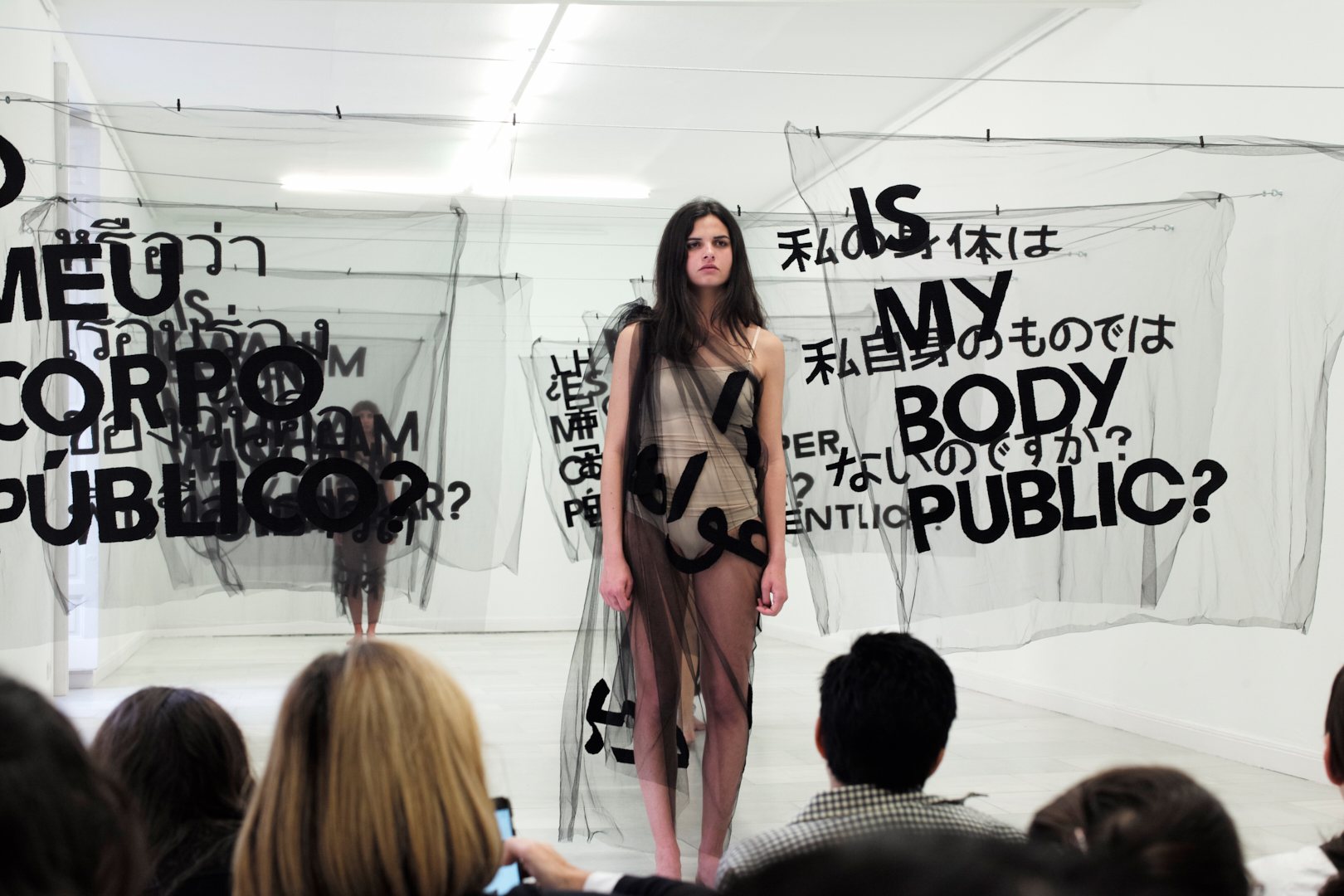
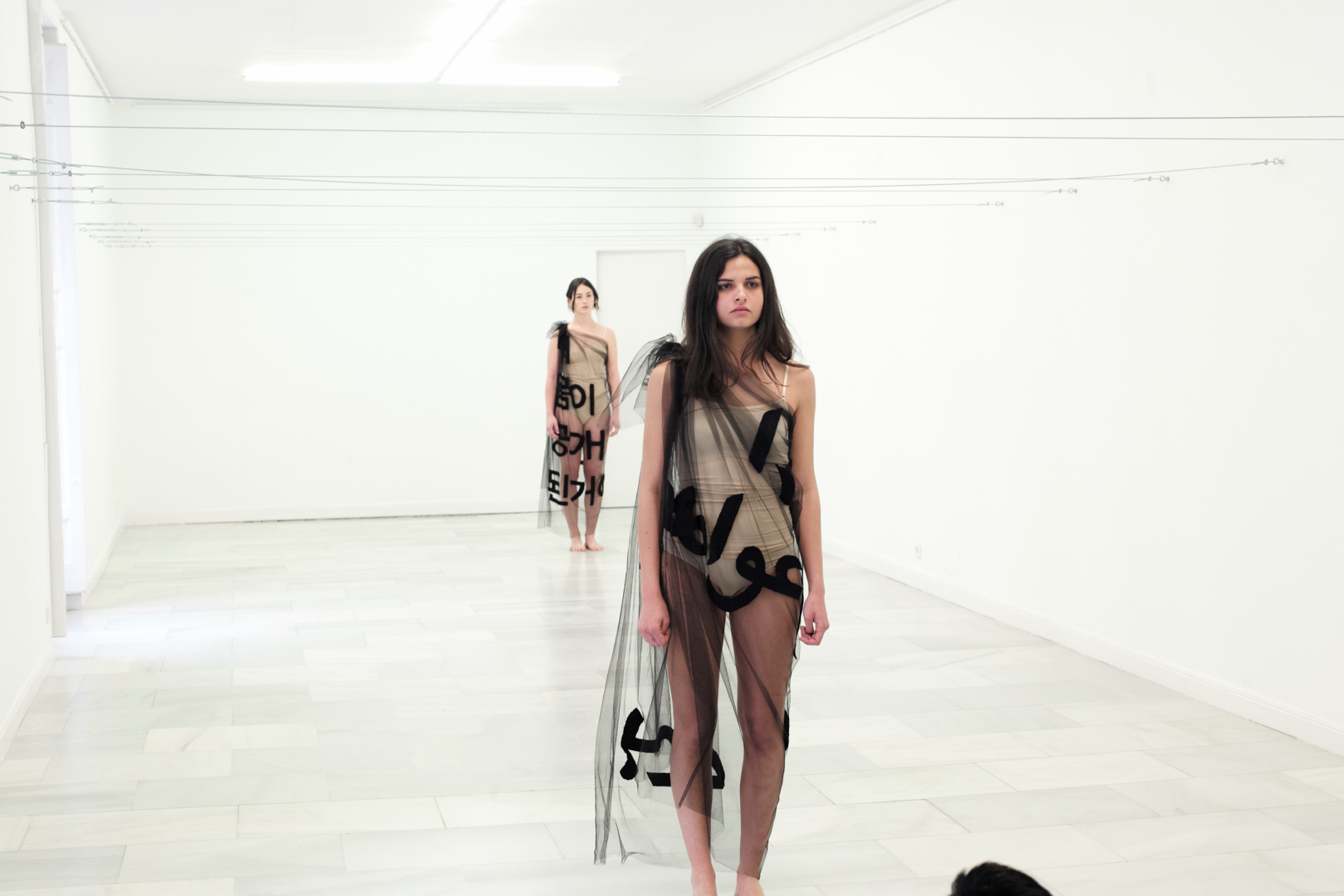
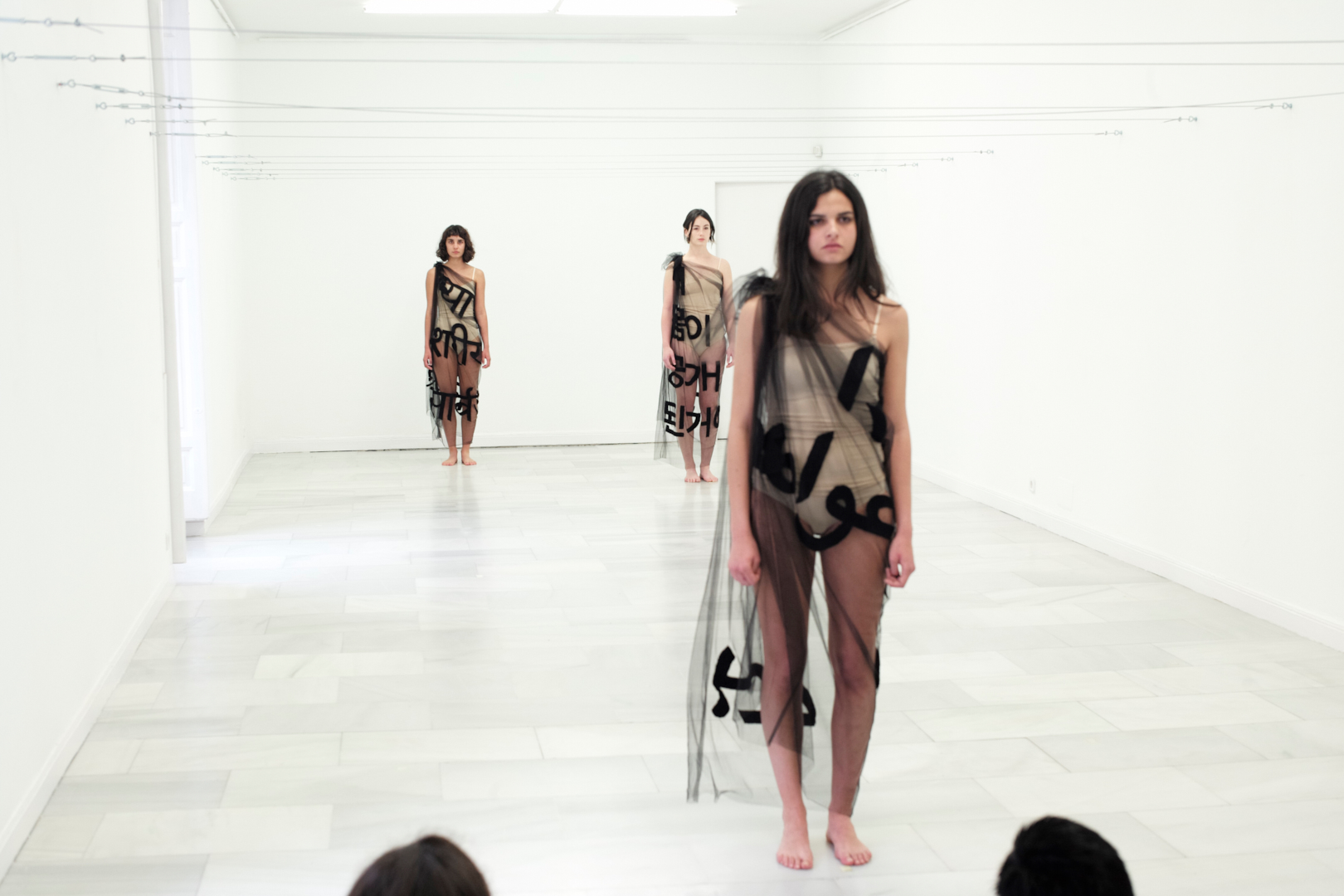
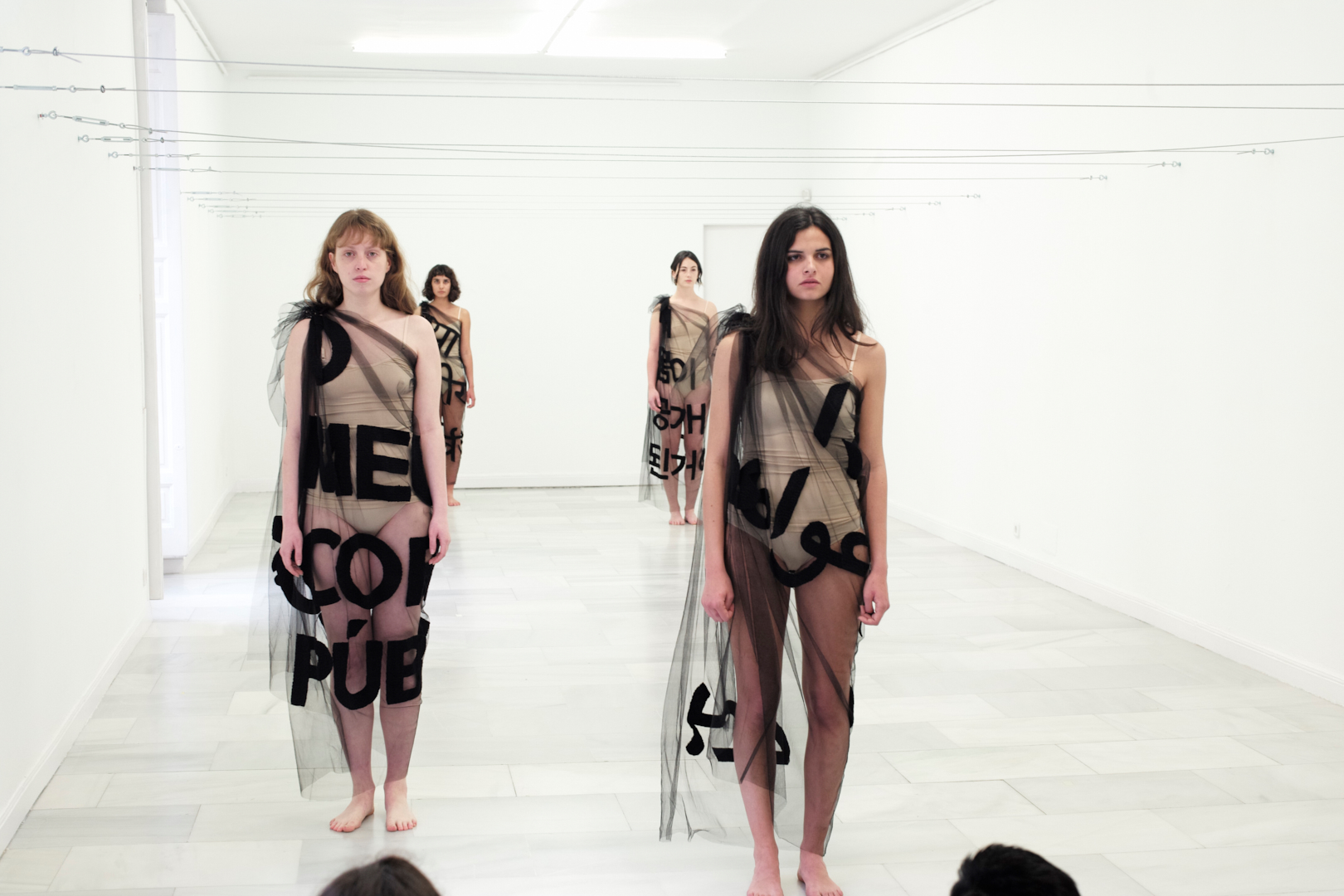
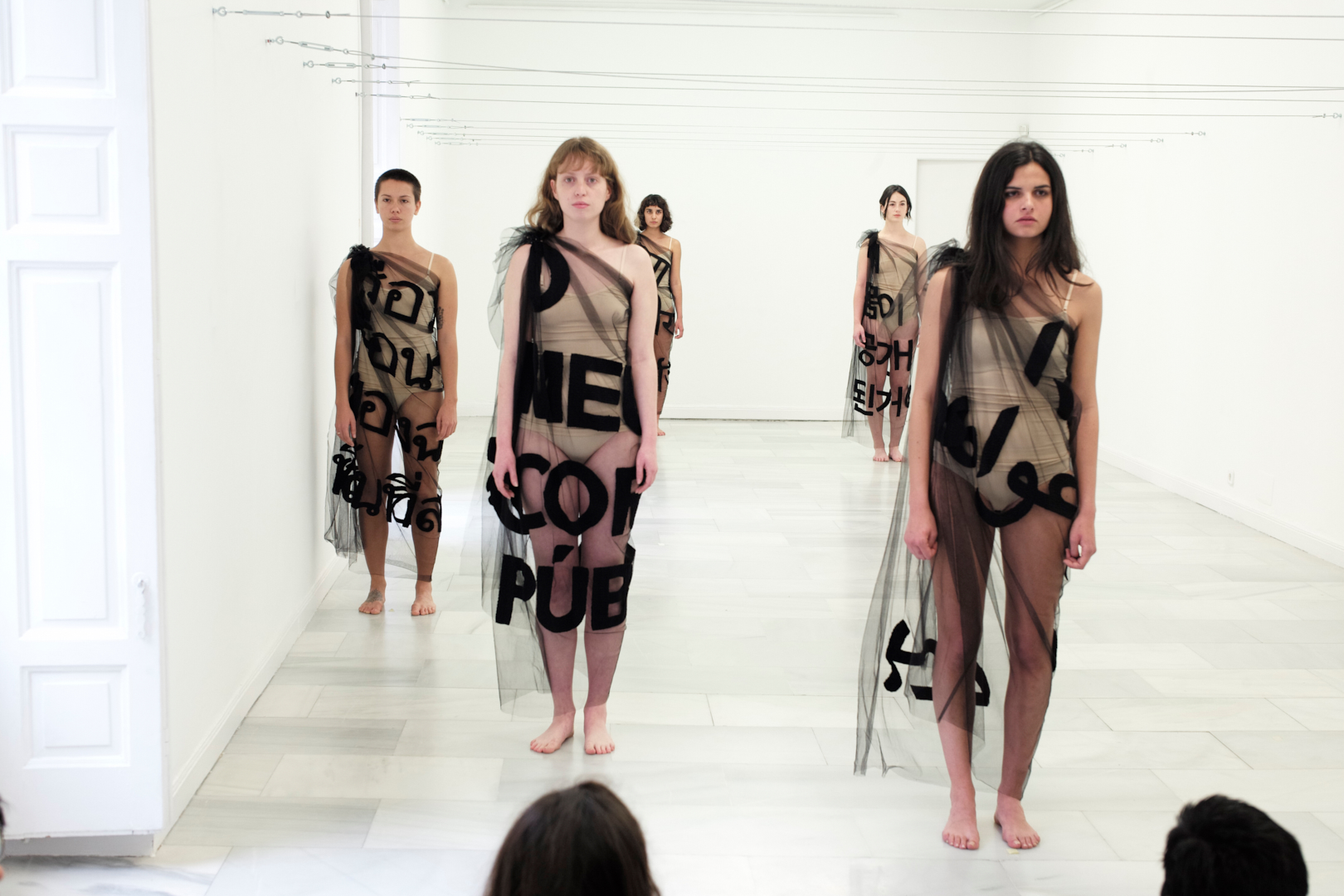
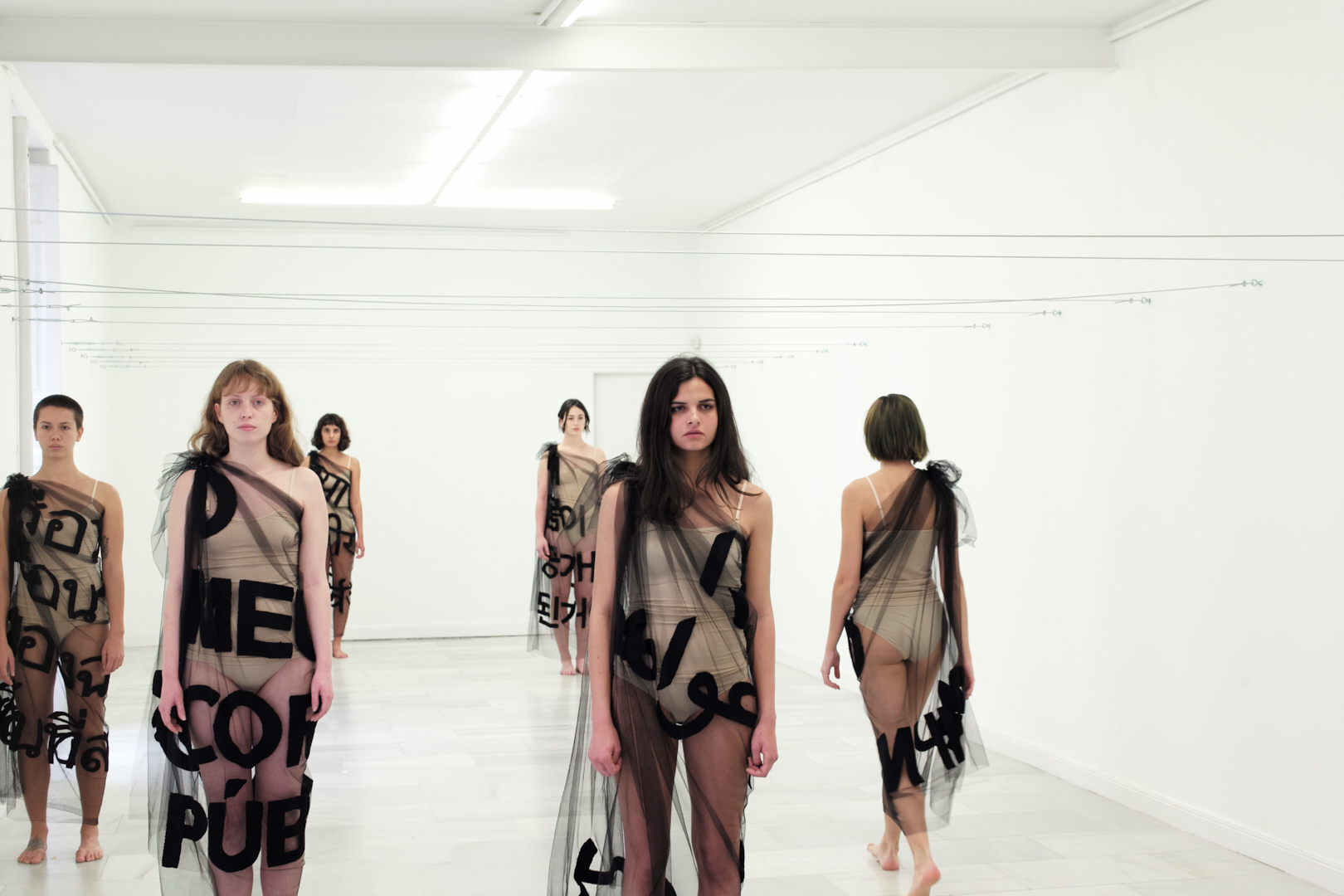
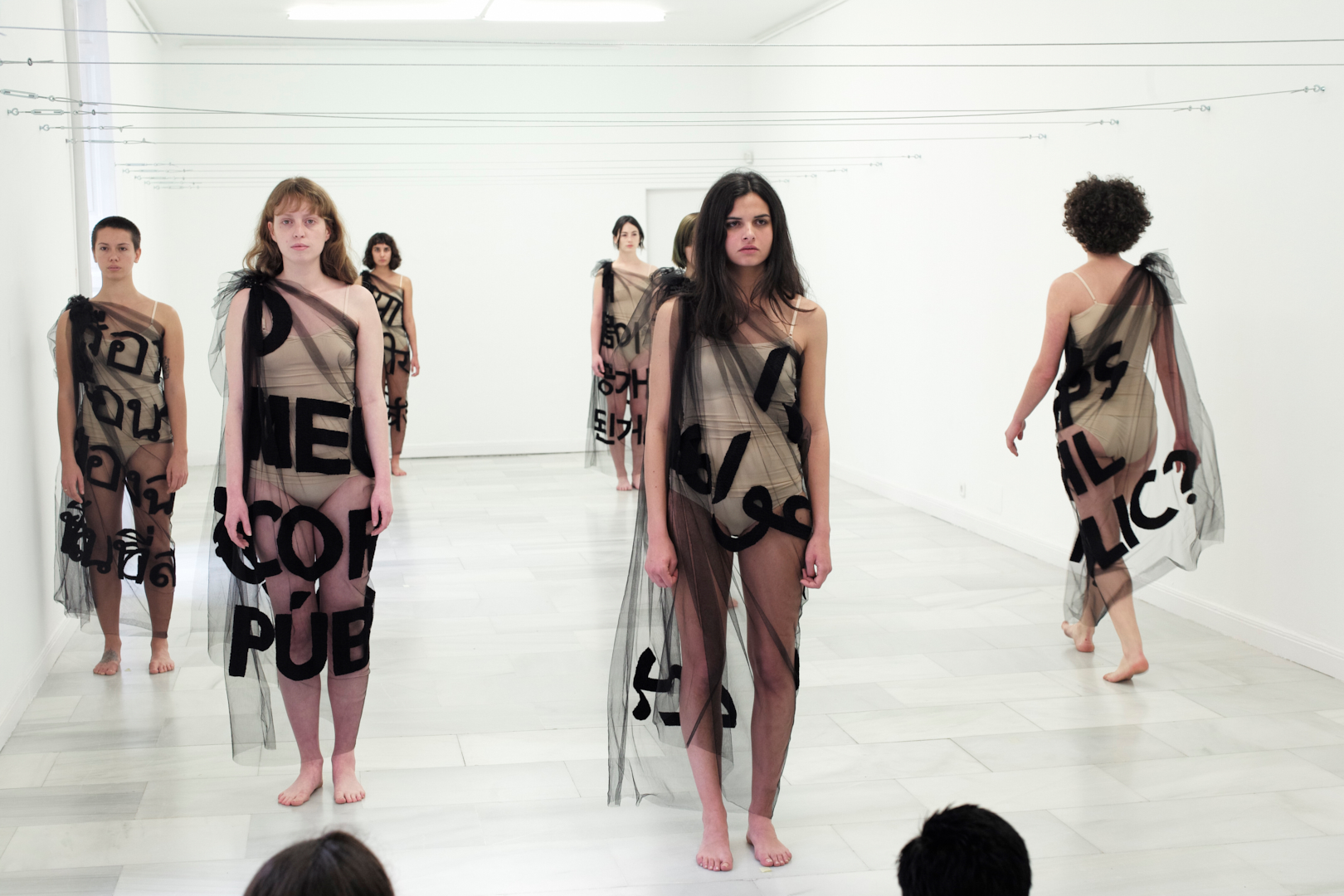
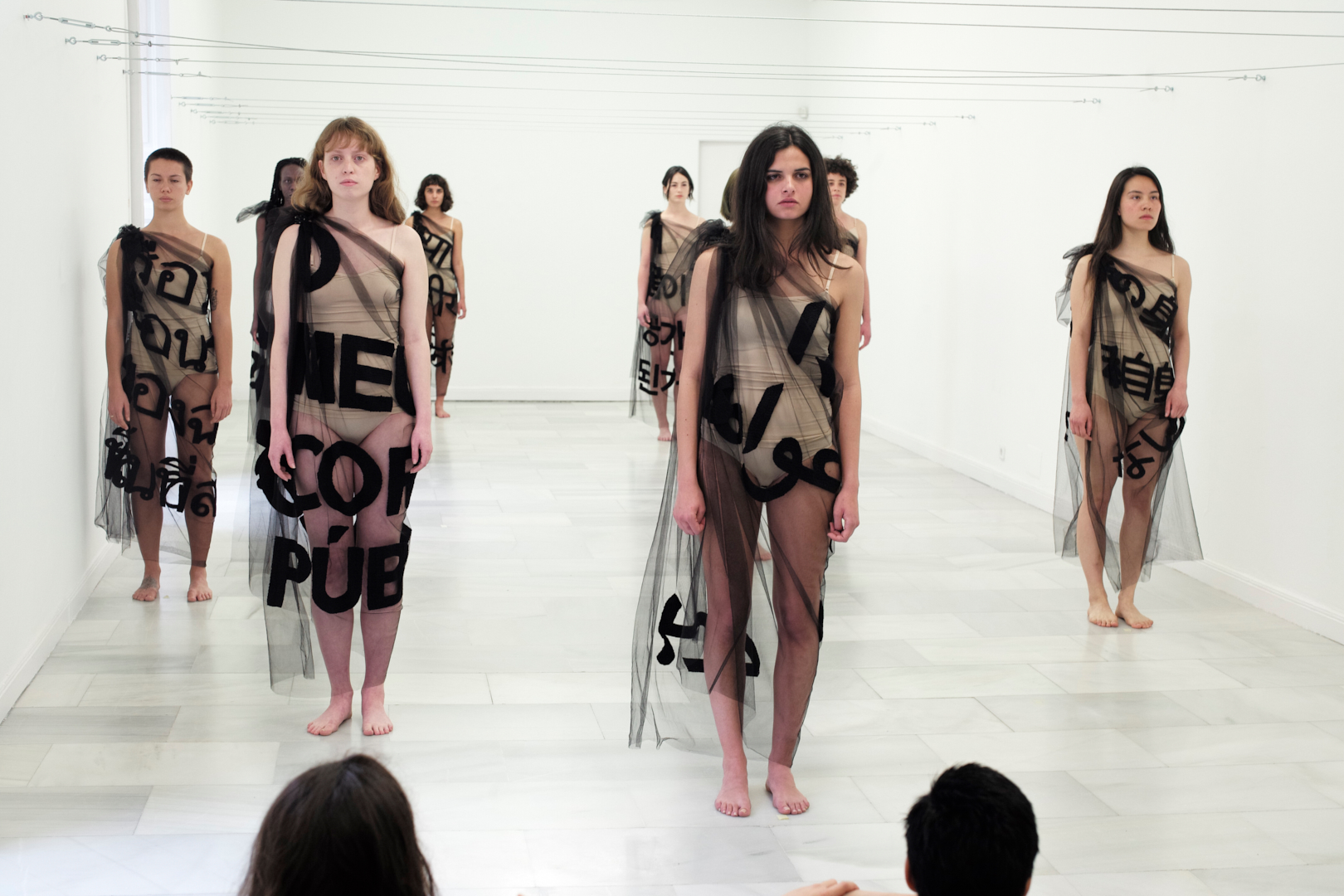
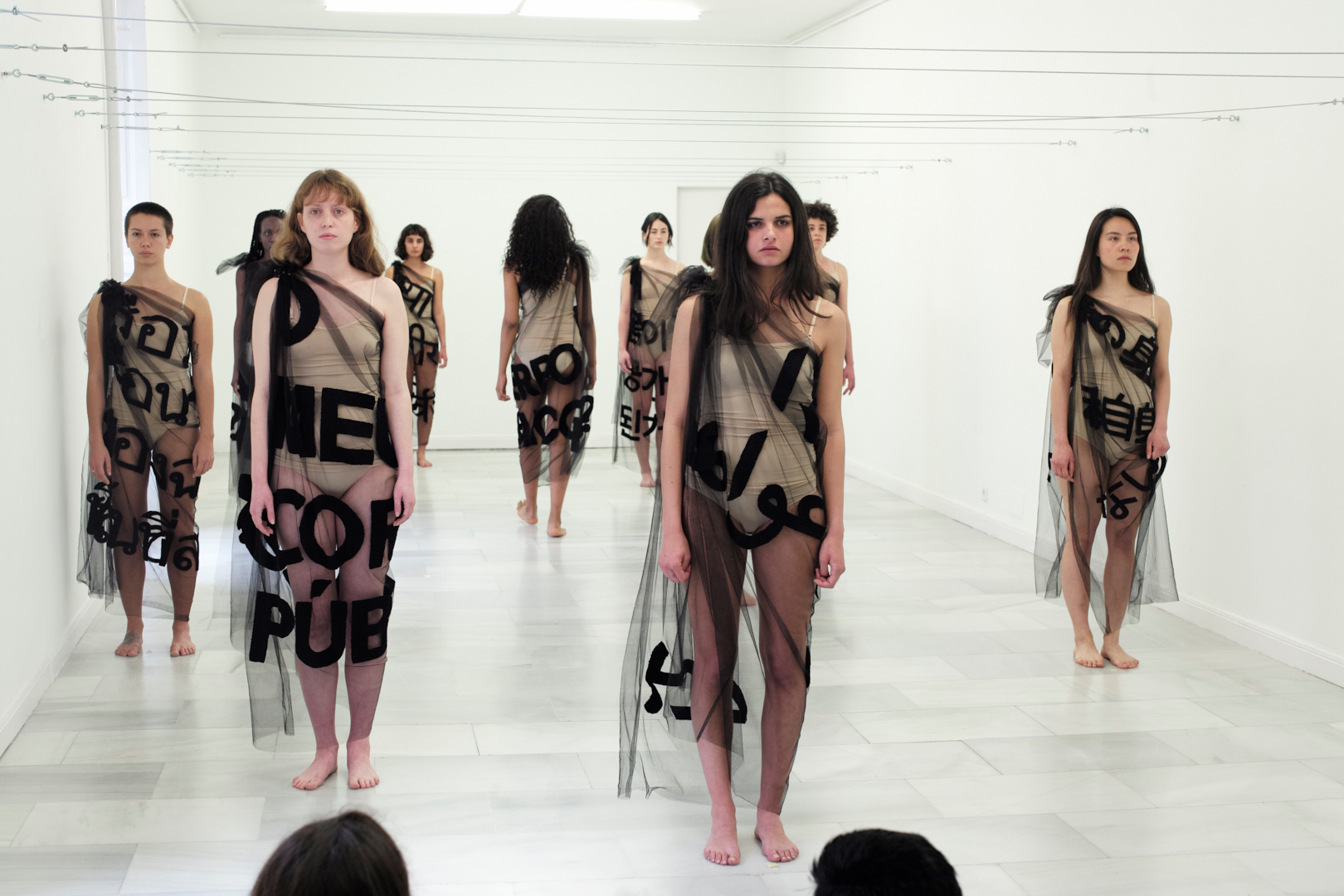
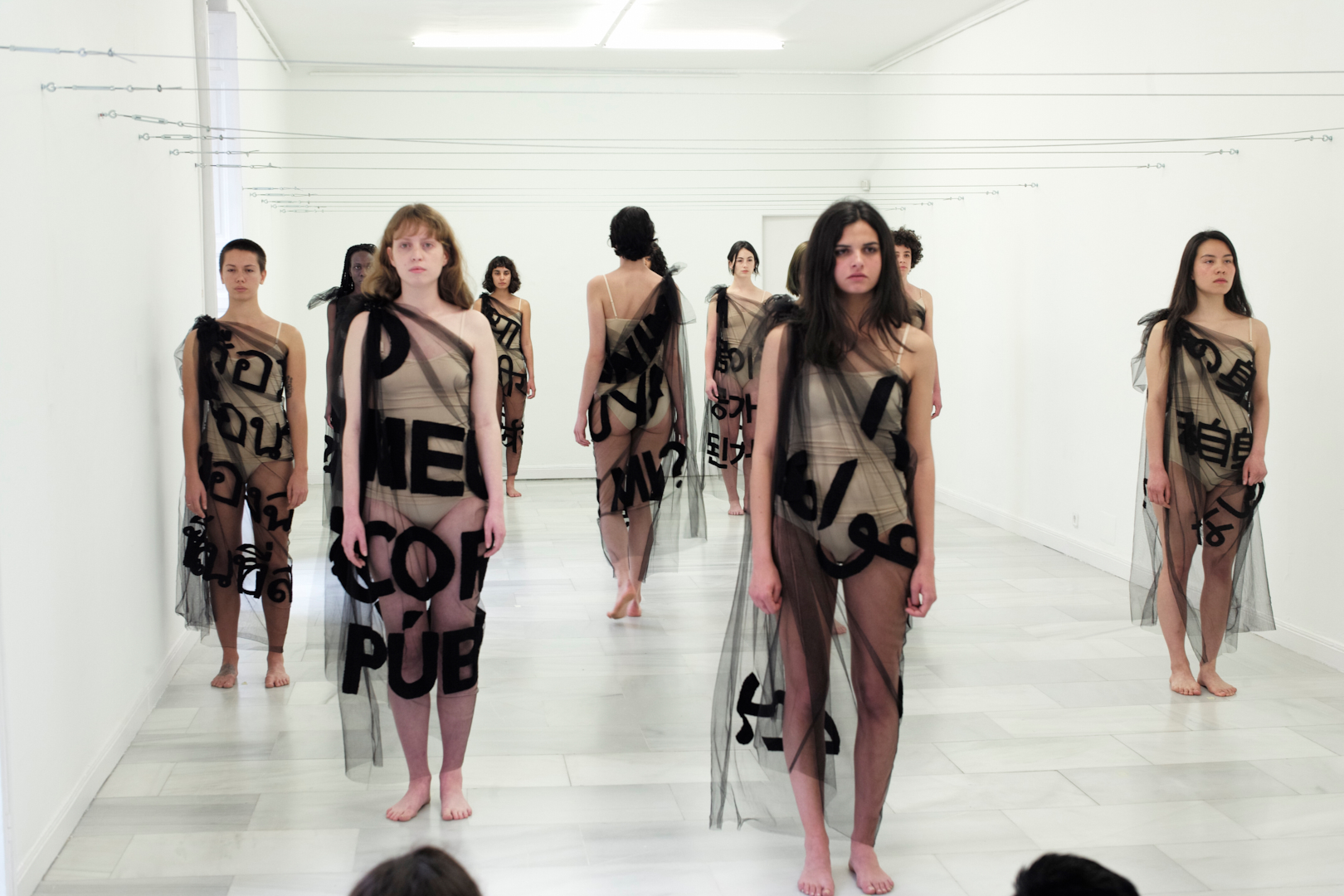
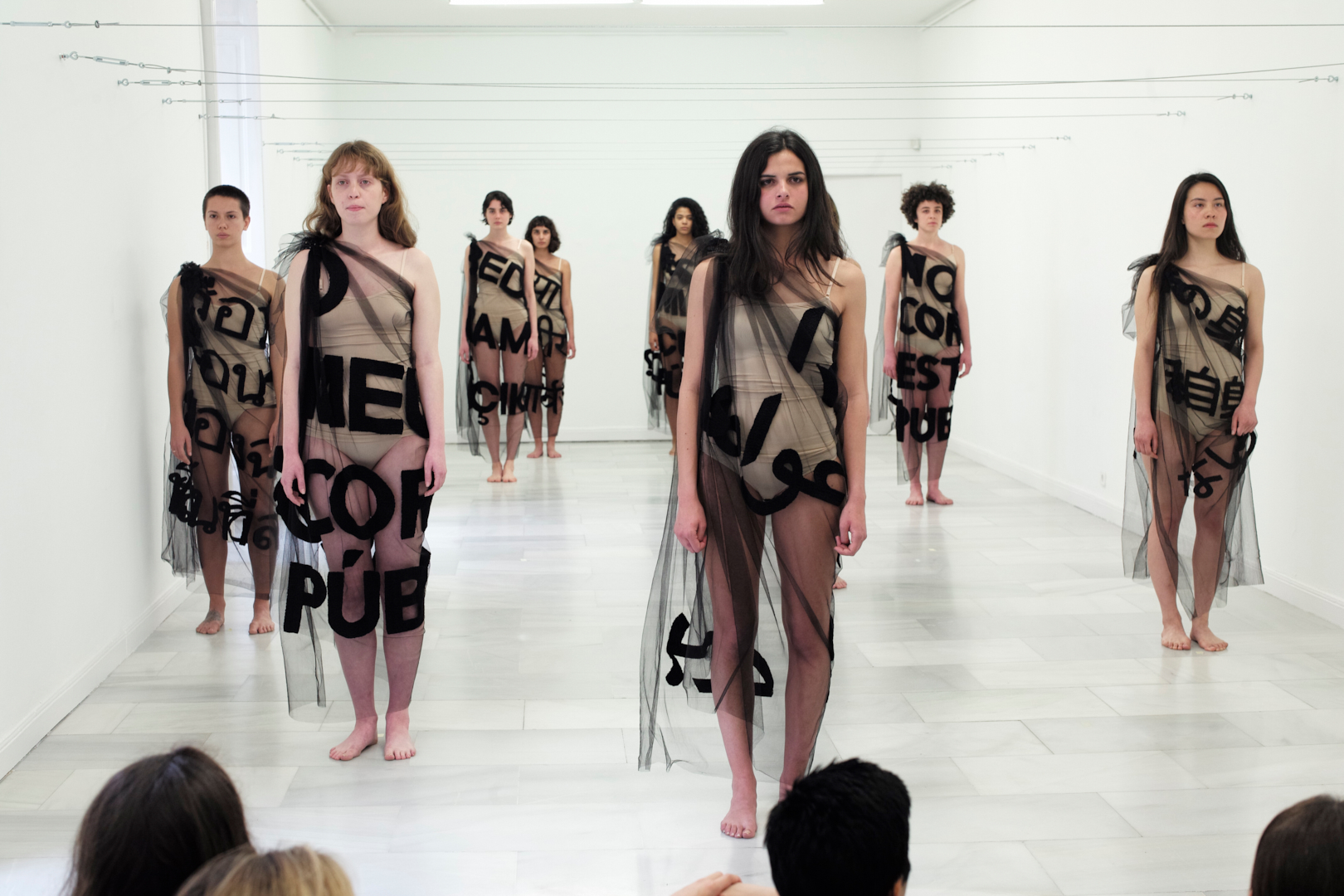
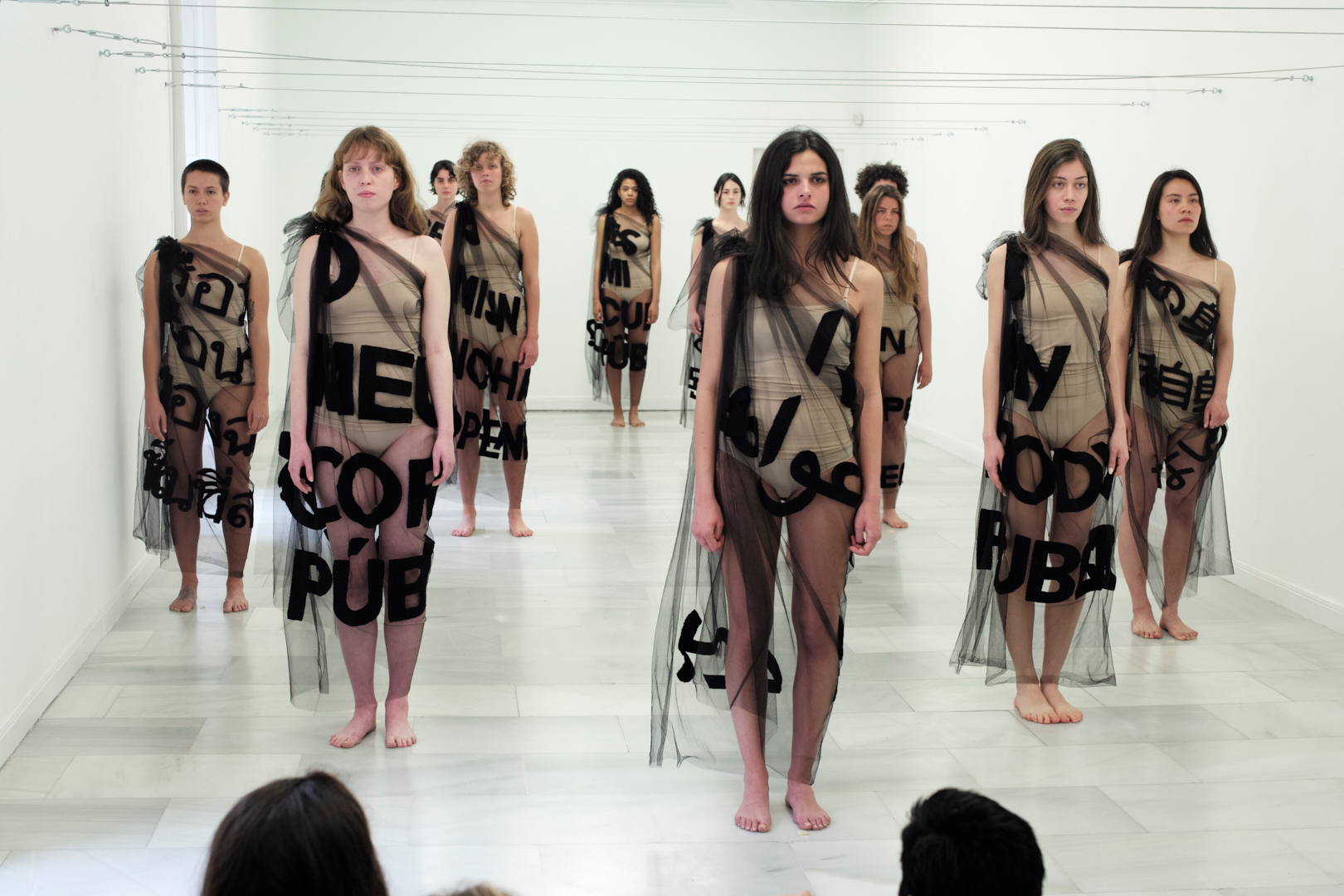
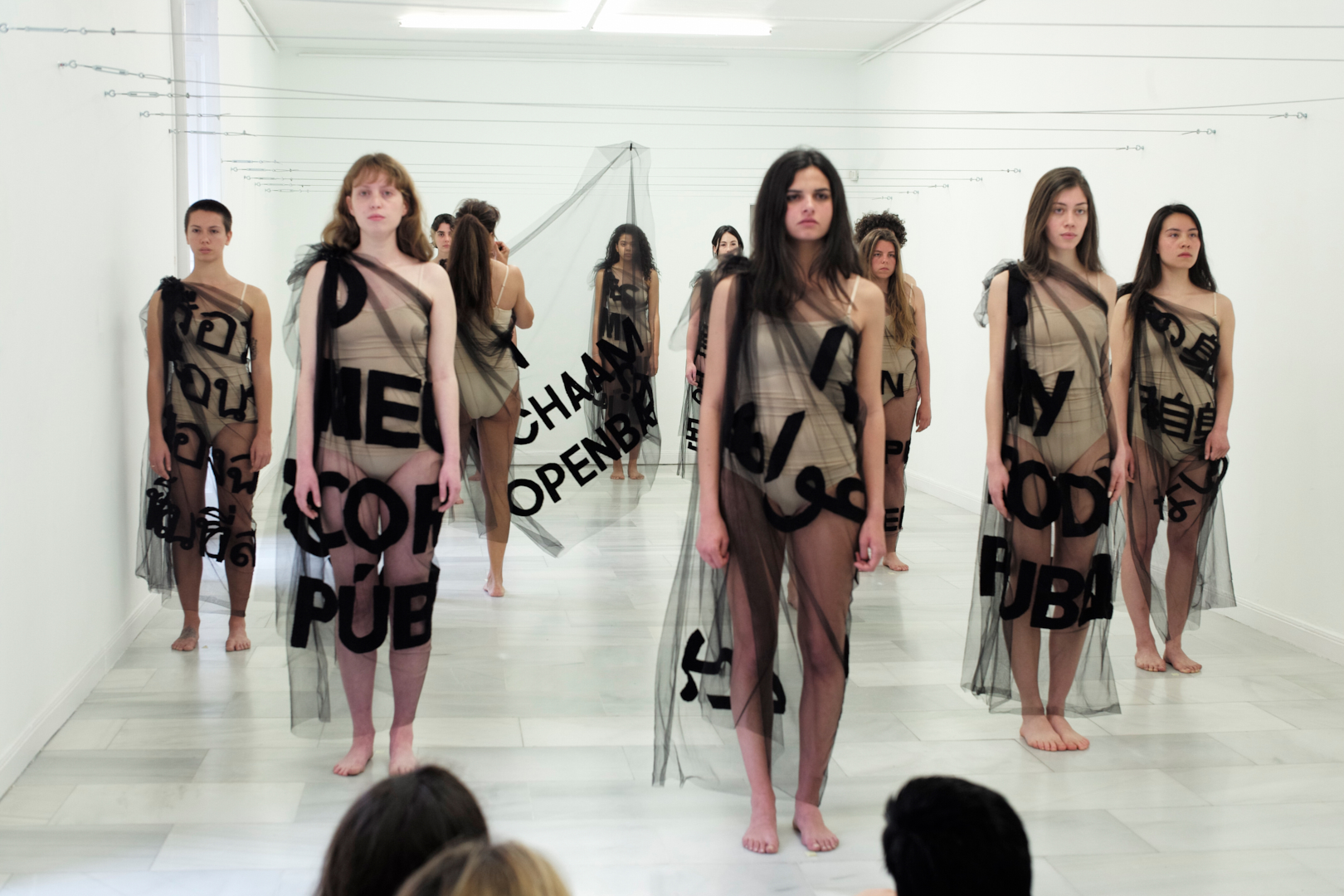
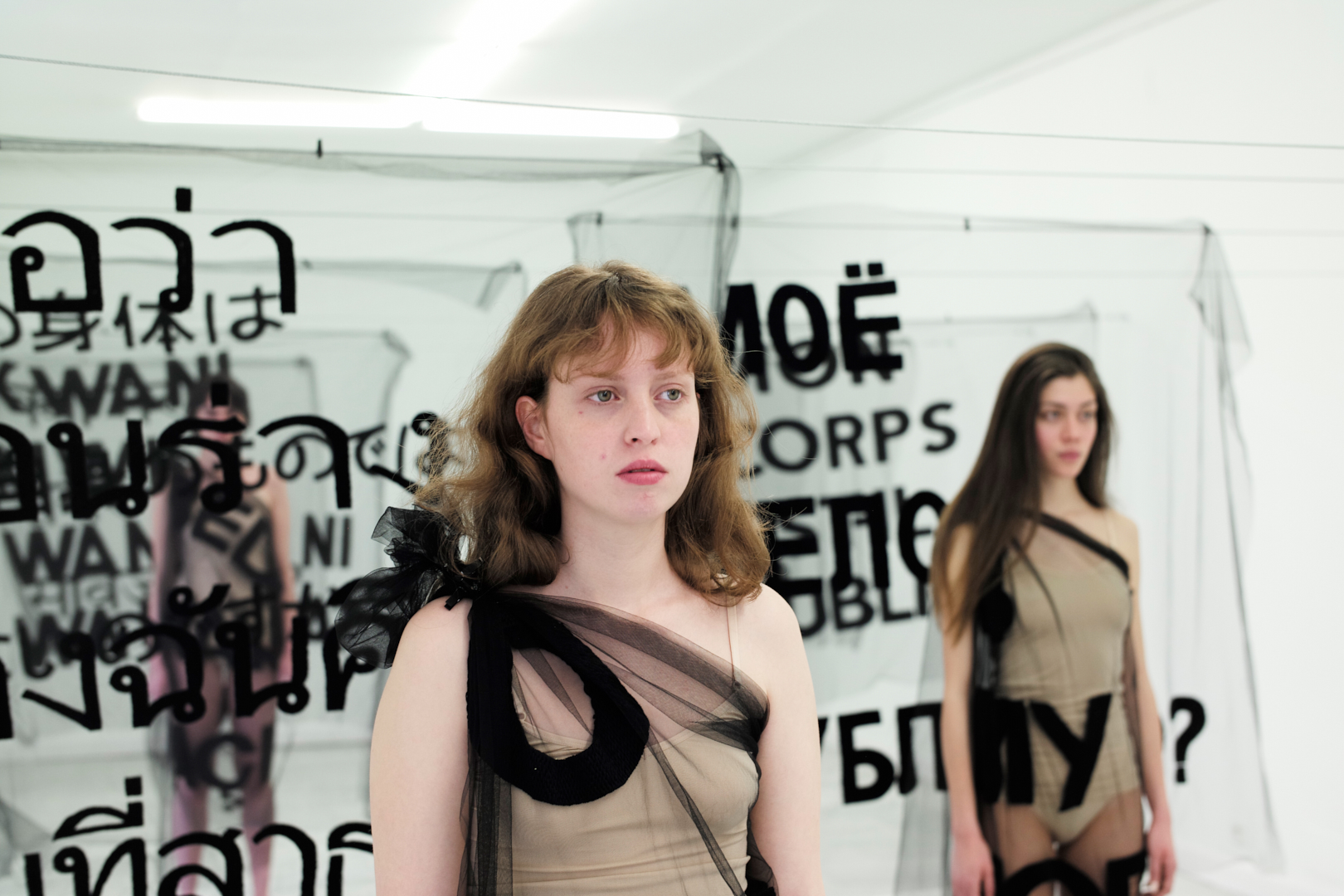
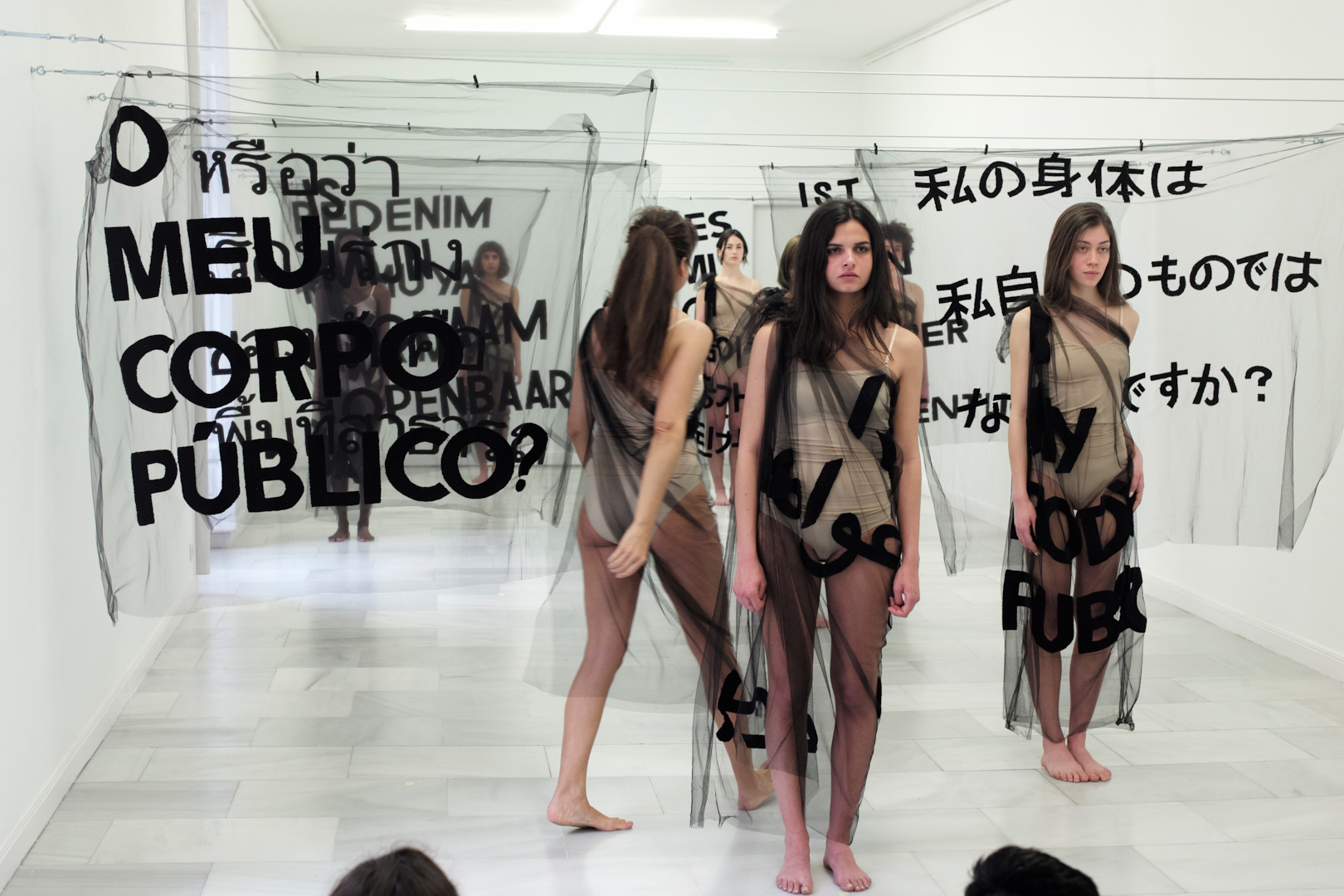
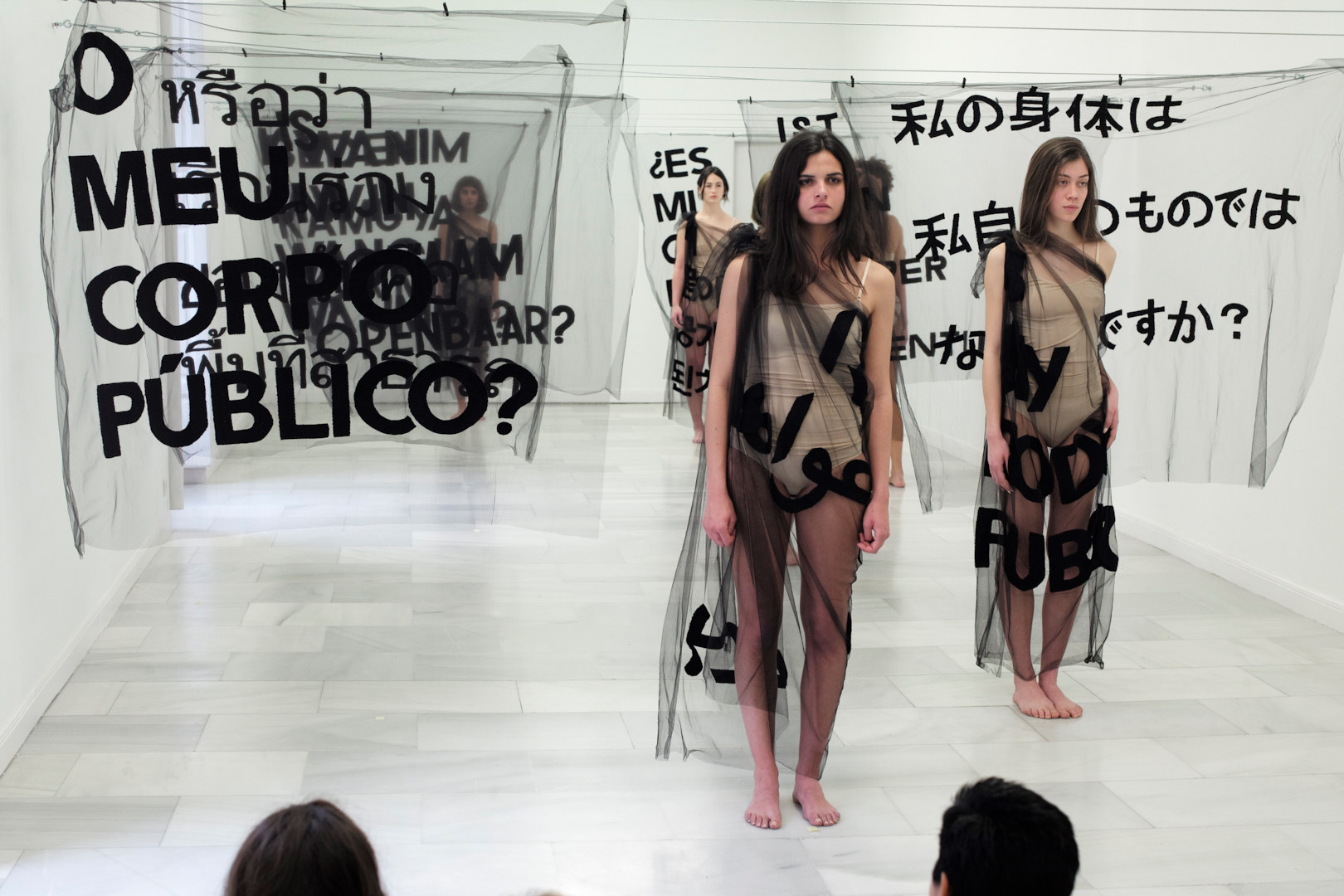
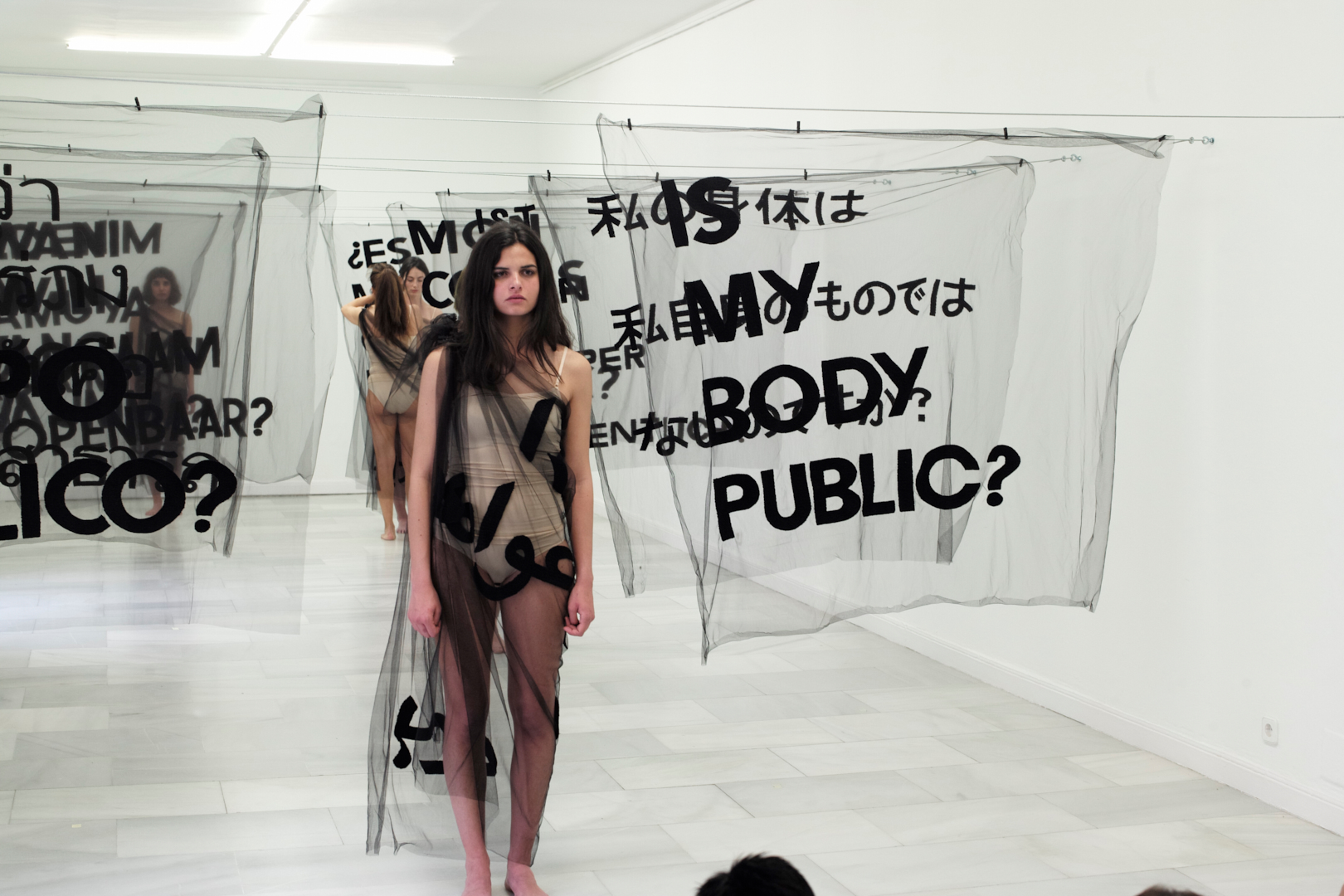
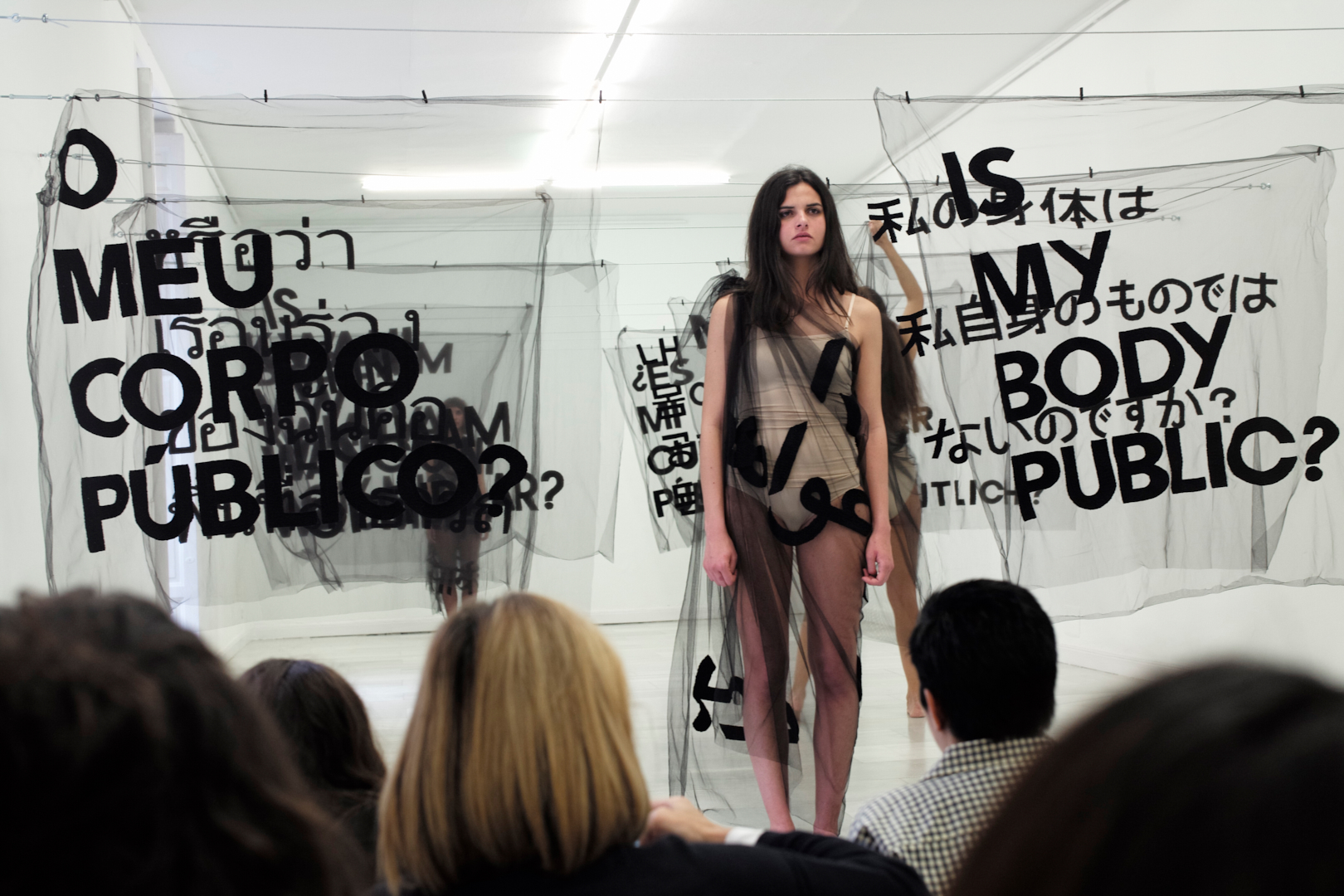
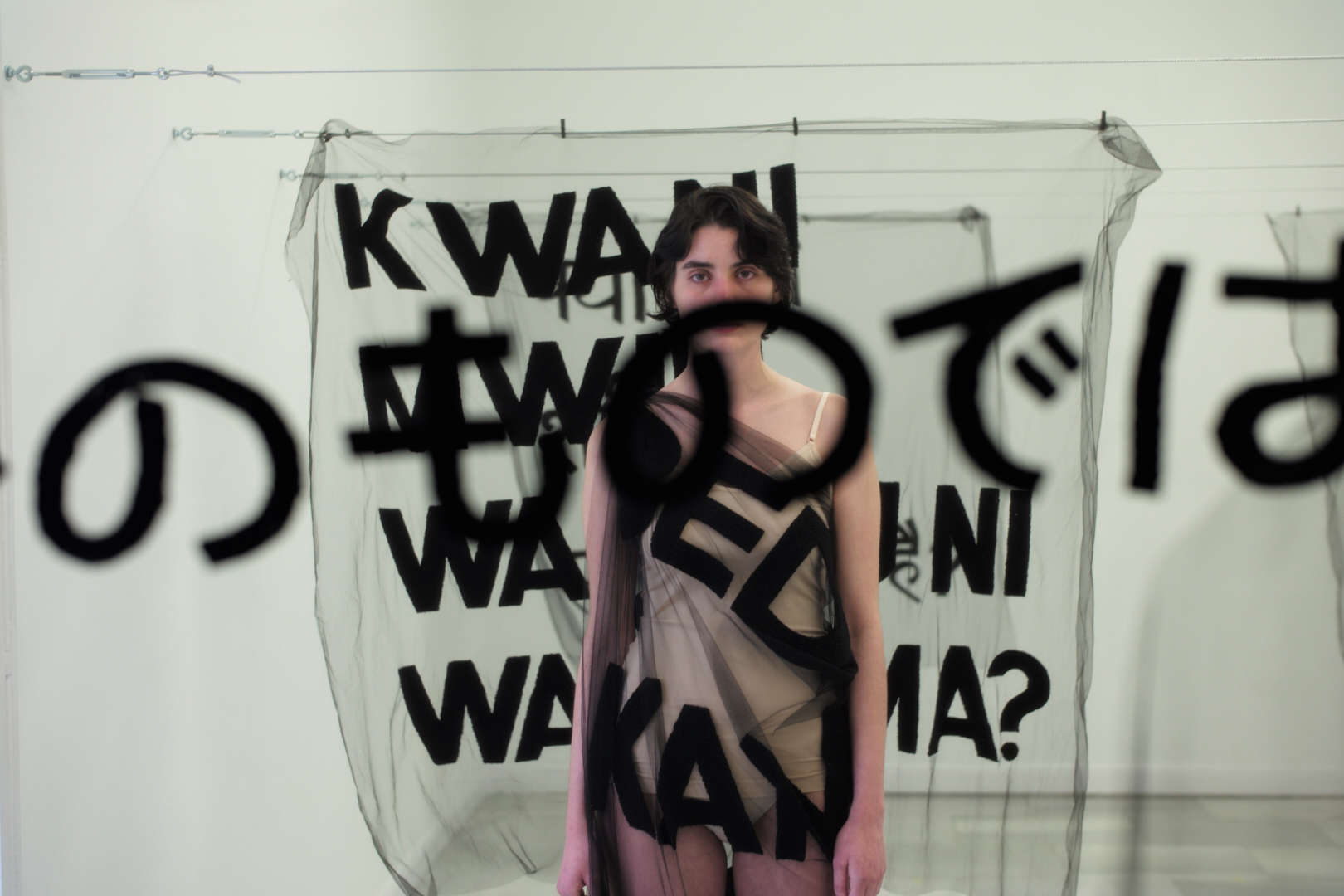
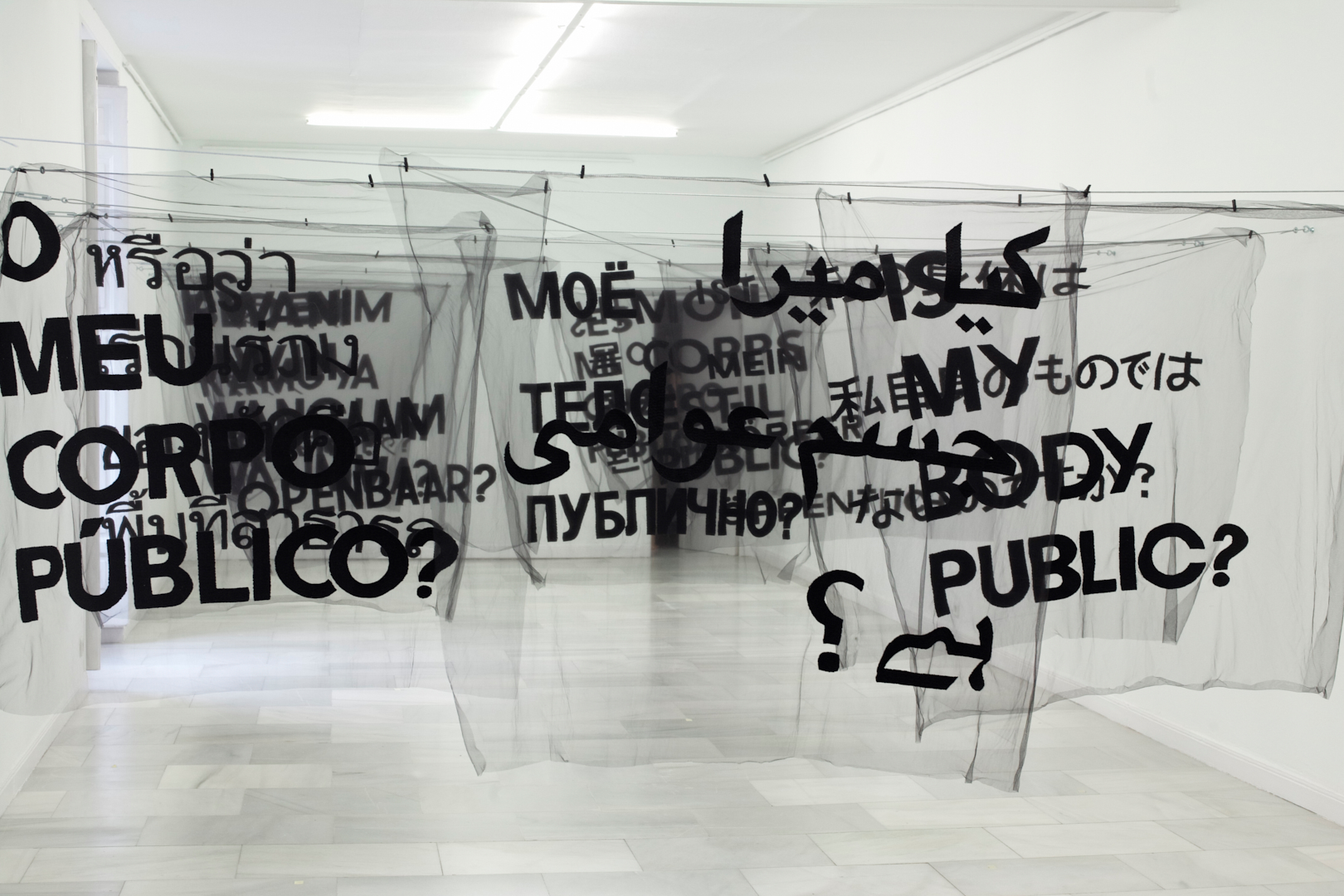
For this work Framis has designed new garments with which she explores the borders of that which is private and that which is public. The aesthetics of the dresses resemble that of lingerie, a material usually associated with the private realm. The dresses are made from thin transparent fabrics, but are at the same time banners for public demonstration and used as such.
The dresses carry a strong message embroidered onto them. “Is My Body Public” ask each of the 15 dresses, in 15 different languages. With the work, Framis wants to represent this issue that women deal with worldwide. The slogan “Is My Body Public” was translated by 15 different women, each from the region where the specific language is spoken.
The collection is used actively in a performance demonstration. During the performance 15 women walk through the streets of Madrid wearing the dresses to finally arrive at the Juana de Aizpuru Gallery. This work introduces a new way of demonstrating against sexual violence and intimidation against women. The general passer-by is confronted with the women’s message and asked to reflect upon this. Upon arrival in the gallery the 15 women hang the banners up, like clothing, on a line to dry.
With Is My Body Public Framis questions what is public and what is still private in today’s world. Nowadays it seems as though privacy is something of the past. Our movements, both physical and digital, are followed constantly. We have given up a lot of our privacy with the introduction of the internet and with new technologies. When going through airport security we are closely searched by guards. The government collects all kinds of data about its citizens that is in fact very private information. Framis asks herself where her privacy ends. Where does the fear of the other and the need to control people by gathering as much information as possible begin?
The issues of privacy and body politics Framis discusses in this work take on a different, more specific meaning for women. Women in many countries worldwide are still not allowed to make decisions that concern their body, for example in places where women have to obey certain dressing rules or codes. At the same time women’s bodies, appearances and ways of dressing seem to be a subject that the public, in particular men, think they can publically comment on or critique however they like, for instance by harassing women in the streets. Women’s bodies in these cases seem to be viewed as public property. In many places in the world women are not able to undergo legal, safe abortions and in many places where this is possible women are judged for doing so. Here again others, often men, are deciding over women’s bodies and their sexual and reproductive rights. These are just a few examples of social issues regarding sexism and women’s rights that lead to the question Framis is posing with this work.
The dresses offer a tool for women to explore different, playful ways of demonstrating important issues such as (systematic) sexism. By working together with women from different backgrounds in the performance the work gains a participatory and global character.
Text: Nina Svenson
Supported by: Mondriaan Fonds and Elan Fashions
Production: Maria Ona and Laura Dima
Graphic design: Alex Gifreu
Embroidery made by: Elan Fashions
Special thanks to: Karen Park Goude and Pablo